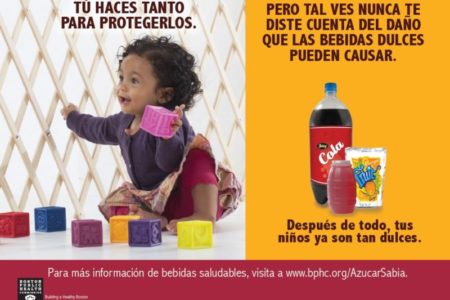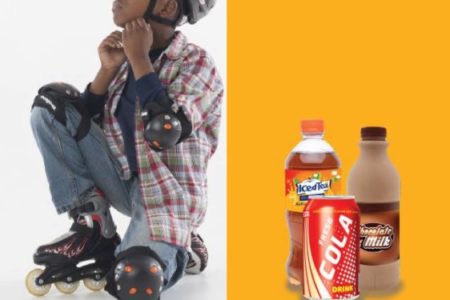Share On Social!
The Boston Public Health Commission (BPHC) was ready to step up the fight to improve health in the face of rising obesity problems among racial/ethnic populations. Latino and black high-school students were especially overweight/obese (34.2% and 35.9%, respectively), possibly due to the fact that 24% of students consume at least one soda daily, according to a study. The BPHC developed a bilingual public health campaign against sugary drinks to help racial/ethnic residents make healthier choices.
EMERGENCE
Awareness/Learn: Obesity is typically a bigger problem among racial/ethnic populations.
Boston, which is increasingly diverse, with an 18% Latino and 24% black population, exemplifies this disparity.
In 2010, Latino and black high-school students were very overweight (34.2% and 35.9%, respectively), and this trend continued into adulthood, with 64.2% obesity among Latinos and 69% among blacks.
In 2011, the Boston Public Health Commission (BPHC) tried to get ahead of the curve and target sugar reduction among minority population with a bilingual campaign called “Azucar Sabia (Sugar Smarts).”
This campaign went up in communities around Boston, educating parents about how sugar-sweetened beverages can cause harm to their children through obesity, diabetes, and tooth decay.
This campaign was well received but did not make a major impact on the community, health officials said.
 Frame Issue: In 2014, obesity and related illnesses were still a major issue for Latino and black residents.
Frame Issue: In 2014, obesity and related illnesses were still a major issue for Latino and black residents.
BPHC began to revisit the idea of a sugary drinks marketing campaign. Although their first campaign was well-designed, BPCH officials believed they could improve it.
Improving and re-launching the “Sugar Smarts” campaign would mean evaluating what worked and did not work in the first campaign.
DEVELOPMENT
Education/Mobilization: BPHC secured funding from the REACH (Racial and Ethnic Approaches to Community Health) grant program.
The first step in re-launching their ad campaign was to find out what people liked about the first campaign, and what could be improved. Working with an outside facilitator, BPHC asked members of the communities where the revamped ads would be featured to participate in focus groups.
These community members were told about the campaign and asked to evaluate the overall look and message that the ad was sending. Gaining support and approval of these Boston residents was greatly important to the BPHC because these communities were still largely targeted by junk food advertisers, and the “Sugar Smarts” campaign could help change that, BPHC officials said.
Debate: The focus groups gave BPHC a lot of feedback that helped shape their future plans.
Residents found the ads to lack color and were confused on the subject. The empty bottles in the first campaign made users think they were telling parents to protect their children from cleaning supplies, as the ads never said the words sugary drinks or beverages.
However, the focus groups did appreciate that the ads acknowledged how much parents do for their kids, validating the way parents care about the health of their children. They also found the tagline—“After all, your kids are sweet enough already”—to be endearing and positive, instead of using angry or negative language.
“People really attached to that,” said Maura Ackerman, project manager for BPHC. “It’s a playful way of saying kids don’t need more sugar.”
BPHC began to look at how they could improve the clarity and colors of the ads, while keeping the same message against sugary drinks.
ENACTMENT
Activation: To reach their target residents, BPHC officials explored ad locations.
They picked six areas of Boston with the highest populations of Latinos and blacks, two demographics chosen because of their high obesity rates.
Community members helped the “Sugar Smarts” team find the best places to place ads by pointing out heavy areas of marketing and fast-food restaurants.
Frame Policy: With feedback from focus groups and target areas chosen, BPHC began to choose specific places to run their ads. They used Google Maps to view areas with billboards, bus shelters, and other ad space that was often used for fast-food or other food advertising.
They decided that they would buy these ad spaces, so that residents not only saw their campaign, but also saw less unhealthy marketing, something the community greatly supported.
“Many of the neighborhoods are really upset about the additional marketing that is targeted in their neighborhoods,” Ackerman said. “Where we knew about that happening, we did our best to buy ad space we knew had been previously used for that kind of marketing.”
 Change: BPHC approved the ads for the “Sugar Smarts” (or “Azucar Sabia” for Spanish ads) for placement in May 2014.
Change: BPHC approved the ads for the “Sugar Smarts” (or “Azucar Sabia” for Spanish ads) for placement in May 2014.
The BPHC made a few small changes to the ads to give parents a clearer message about the importance of keeping kids away from sugary drinks.
The ads feature a boy putting on a helmet and a young girl in front of a baby gate, both featuring the words: “You do so much to protect them. But, maybe you never realized how much sugary drinks could hurt them. After all, your kids are sweet enough already.”
IMPLEMENTATION
Implementation: In May 2014, “Sugar Smarts” ads started to appear on billboards, bus shelters, on the outsides and insides of buses, outside grocery stores, and key-stop stations (the subway system in Boston).
The ads featured a bilingual website with more information. On this site parents could find out how to spot sugary drinks, the harmful effects of sugary drinks, what they can do for their kids, and more info about the campaign.
Along with the print ads, BPHC developed a 30-second TV ad. This commercial ran on local Boston channels in both English and Spanish. To reach Latinos, ad time was purchased to show the Spanish language commercial 40 times on the local Univision station during the 2014 World Cup.
The ads were popular.
“It was met with a lot of success, people felt like it was a really positive image, really giving parents credit for all the work that they do to protect their kids and think about their health and wellbeing,” Ackerman said. “They help them to wear a seat belt or a car seat or put up a baby gate or help them put a helmet on when they’re biking, so we give them a lot of credit for what they do while letting them know that this way is another way to have a role in protecting their kids.”
Equity: To maintain attention for the campaign, BPHC utilized Twitter and Facebook.
They posted once to Facebook and 2-3 times to Twitter per day to keep the sugary drinks conversation going.
BPHC also used the hashtag #AzucarSabia, the Spanish title for the campaign, to allow users to keep up with the discussion. To continue discussion they also participated in Tweetchats on Twitter, online discussions organized by a specified hashtag, to spread more awareness about sugary drinks and the “Sugar Smarts” campaign.
The “Sugar Smarts” website is also still available for parents and community members to access, in both English and Spanish.
Ads stayed on billboards, bus shelters, and MBTA Subway Stops until mid-June (when their advertising contract ended).
For several more weeks, the ads could still be seen on the sides of buses throughout Boston.
Sustainability: The BPHC plans to continue with their online promotion of “Sugar Smarts” campaign by participating on Twitter and by hosting their own Tweetchats in Spanish.
To continue promoting healthy beverage choices in Boston, they are also beginning a sugary drinks labeling project, meant to show people what drinks are the best choices in grocery and corner stores.
BPHC plans to continue to fight the health disparities in their communities and combat childhood obesity throughout Boston.
This success story was produced by Salud America! with support from the Robert Wood Johnson Foundation.
The stories are intended for educational and informative purposes. References to specific policymakers, individuals, schools, policies, or companies have been included solely to advance these purposes and do not constitute an endorsement, sponsorship, or recommendation. Stories are based on and told by real community members and are the opinions and views of the individuals whose stories are told. Organization and activities described were not supported by Salud America! or the Robert Wood Johnson Foundation and do not necessarily represent the views of Salud America! or the Robert Wood Johnson Foundation.
ABOUT THE PROGRAM
Salud America! The RWJF Research Network to Prevent Obesity Among Latino Children is a national program of the Robert Wood Johnson Foundation. The program aims to educate researchers, decision-makers, community leaders, and the public in contributing toward healthier Latino communities and seeking environmental and policy solutions to the epidemic of Latino childhood obesity. The network is directed by the Institute for Health Promotion Research at the University of Texas Health Science Center at San Antonio.
For more information, visit http://www.salud-america.org.
By The Numbers
1
Supermarket
for every Latino neighborhood, compared to 3 for every non-Latino neighborhood
This success story was produced by Salud America! with support from the Robert Wood Johnson Foundation.
The stories are intended for educational and informative purposes. References to specific policymakers, individuals, schools, policies, or companies have been included solely to advance these purposes and do not constitute an endorsement, sponsorship, or recommendation. Stories are based on and told by real community members and are the opinions and views of the individuals whose stories are told. Organization and activities described were not supported by Salud America! or the Robert Wood Johnson Foundation and do not necessarily represent the views of Salud America! or the Robert Wood Johnson Foundation.



